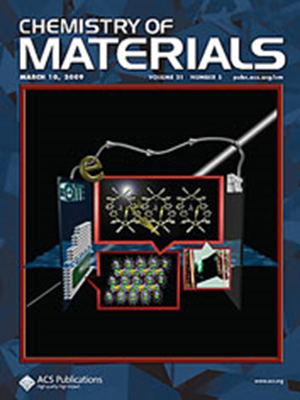揭示阳离子交换控制下CdxAgySe量子点的自掺杂性质
IF 7
2区 材料科学
Q2 CHEMISTRY, PHYSICAL
引用次数: 0
摘要
金属硫族纳米晶体在其生长过程中不可避免地经历一种非化学计量比状态。考虑到少数原子作为掺杂剂的作用,非化学计量组成可以决定材料的基本性质。这种实时的化学计量变化非常快,因此,产物处于具有化学计量积分比的能量稳定状态。在阳离子交换反应中,这种现象变得非常明显。因此,具有可控交换速率的阳离子交换反应是一种极好的方法,可以产生未开发的亚稳态,具有非化学计量学,其中有趣的光学和电学性质出现。在这里,我们报道了处于亚稳态自掺杂状态的阳离子交换CdxAgySe量子点(QDs)在中波长红外(中红外)区表现出带内跃迁。通过控制阳离子交换的反应速率,成功捕获了该状态,并利用低温下短波和中红外光致发光光谱、透射电镜、核磁共振、x射线衍射分析和能量色散x射线光谱对其进行了分析。通过测量基于量子点的红外传感器的红外光电流谱,进一步证实了阳离子交换自掺杂量子点的电子中红外带内跃迁。本文章由计算机程序翻译,如有差异,请以英文原文为准。
Revealing the Self-Doped Nature of CdxAgySe Quantum Dots under Cation Exchange Control
Metal-chalcogenide nanocrystals inevitably experience a state with a nonstoichiometric ratio during their growth. Considering that a few atoms function as dopants, the nonstoichiometric composition can determine the fundamental properties of the materials. Such a stoichiometry change in real time is extremely fast, and thereby, the product lies in an energetically stable state with a stoichiometric integral ratio. The phenomenon becomes dramatic for the cation-exchange reaction. Thus, the cation-exchange reaction with a controllable exchange rate can be an excellent way to generate the unexplored metastable state with a nonstoichiometry where interesting optical and electrical properties appear. Here, we report cation-exchanged CdxAgySe quantum dots (QDs) at a metastable self-doped state exhibiting intraband transition in the mid-wavelength infrared (mid-IR) regime. The state is successfully captured by controlling the reaction rate of the cation exchange and analyzed using short-wavelength and mid-IR photoluminescence spectroscopy under cryo-temperature, transmission electron microscopy, nuclear magnetic resonance, X-ray diffraction analysis, and energy-dispersive X-ray spectroscopy. The electronic mid-IR intraband transition of the cation-exchanged self-doped quantum dots is further confirmed by measuring the infrared photocurrent spectrum of the QD-based infrared sensor.
求助全文
通过发布文献求助,成功后即可免费获取论文全文。
去求助
来源期刊

Chemistry of Materials
工程技术-材料科学:综合
CiteScore
14.10
自引率
5.80%
发文量
929
审稿时长
1.5 months
期刊介绍:
The journal Chemistry of Materials focuses on publishing original research at the intersection of materials science and chemistry. The studies published in the journal involve chemistry as a prominent component and explore topics such as the design, synthesis, characterization, processing, understanding, and application of functional or potentially functional materials. The journal covers various areas of interest, including inorganic and organic solid-state chemistry, nanomaterials, biomaterials, thin films and polymers, and composite/hybrid materials. The journal particularly seeks papers that highlight the creation or development of innovative materials with novel optical, electrical, magnetic, catalytic, or mechanical properties. It is essential that manuscripts on these topics have a primary focus on the chemistry of materials and represent a significant advancement compared to prior research. Before external reviews are sought, submitted manuscripts undergo a review process by a minimum of two editors to ensure their appropriateness for the journal and the presence of sufficient evidence of a significant advance that will be of broad interest to the materials chemistry community.
 求助内容:
求助内容: 应助结果提醒方式:
应助结果提醒方式:


